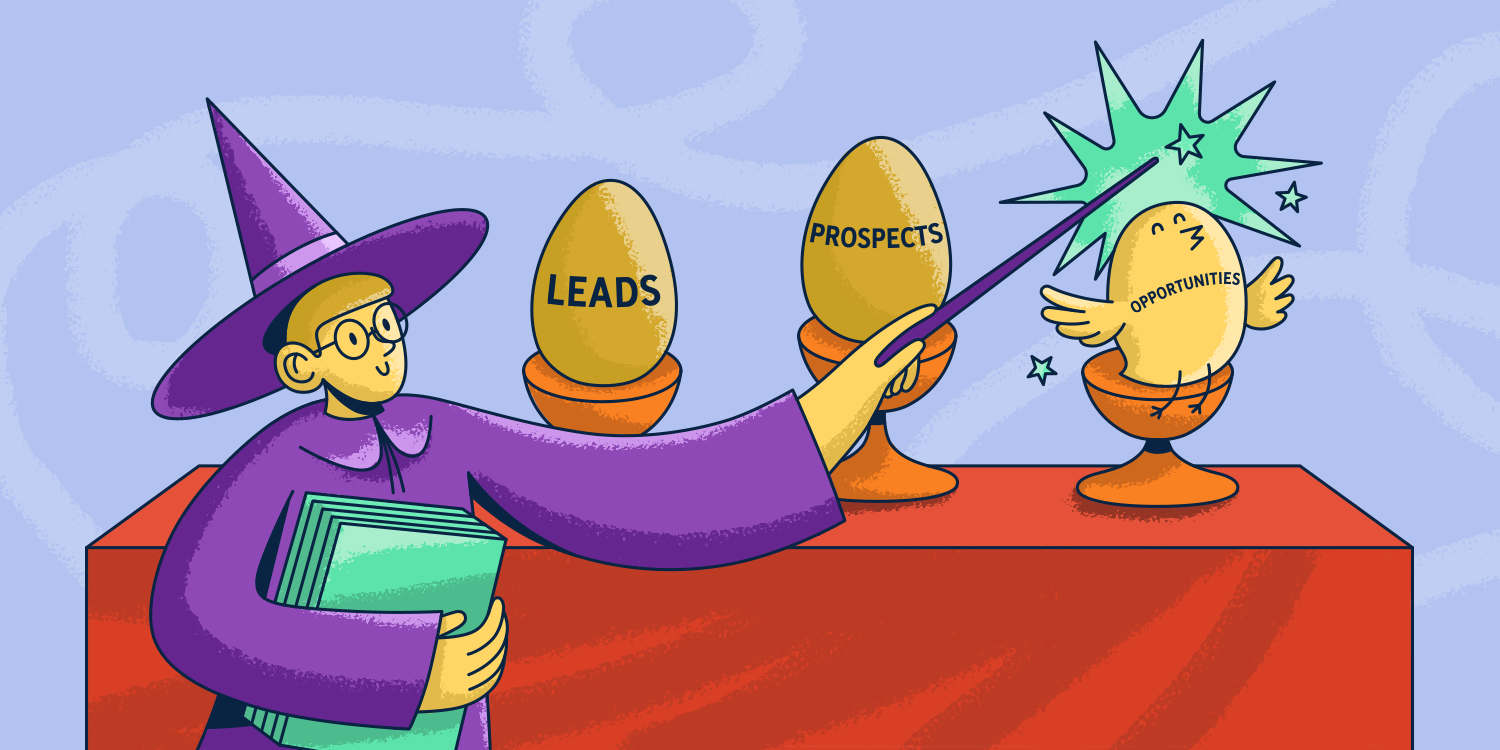When it comes to sales, there are a lot of terms that can seem confusing at first. For instance, what’s the difference between a lead, a prospect, and an opportunity? Do you need to worry about these terms?
As soon as you start working in sales, you’ll realize (or your sales coaches will make you realize) that these three words must be differentiated. Let’s find out why it’s vital for salespeople to draw the line between a lead, a prospect, and an opportunity.
I suggest we start with definitions.
What is a lead?
A lead is someone who has shown interest in what you’re selling but hasn’t bought anything yet.
They may have filled out a form on your website, attended one of your webinars, or downloaded one of your white papers. But it doesn’t mean that they will necessarily become prospects.
To become prospects, leads should meet the criteria you set for your ideal customer profile, such as geographic location, company size, or industry, so they should go through a more in-depth qualification process.
So what is a prospect?
A prospect is someone who has expressed an interest and is actively considering your product or service.
They meet your target market criteria, have the means to purchase your product or service, and, crucially, have the authority to make the buying decision.
To achieve sales success, you should pursue leads and prospects until they become opportunities.
And what is an opportunity?
An opportunity is someone qualified as a prospect who you believe would be interested in buying from you.
This potential customer has the need or desire for your product or service and is thus worth pursuing. They might not have outright said they’re interested in what you’re selling, but certain buying signals indicate they could be a potential customer.
Leads, prospects, and opportunities: What’s the difference?
As you might have noticed, it can be tough to tell the difference between a lead, a prospect, and an opportunity at first sight because their meanings look similar.
Yet the difference exists.
A lead is the very initial stage of your (maybe) future customer, and they remain the leads until they are qualified as prospects, that is your (maybe) future customers who meet certain criteria. A prospect, in its turn, might be considered an opportunity in the following cases:
- A company’s looking for a new solution to address a problem they’re experiencing and is actively doing market research. They visit your website for the first time, then return and study your products, ask questions via your chatbot, etc.
- A company decision-maker is asking about your product or service by phone or email.
- A company is interested in your case studies and is asking you to show some evidence of the successful application of your product.
- A company employee signs up for a free trial or another beneficial offering from your side.
Do you see the pattern? Opportunities are everywhere – it’s just up to you to recognize them.
Why is knowing the difference between a lead, a prospect, and an opportunity important?
You might think, okay, why care about leads and prospects? You just need to determine sales opportunities and deal with them.
The thing is, if you’re only pursuing opportunities, you’re going to miss out on potential customers you might get from unqualified prospects. And believe me, that can be a huge loss.
Your company should be interested in working with all three ‘levels’ of potential customers and know the right ways of dealing with each of them. For example, if you’re emailing a potential customer who has just filled out a lead form on your website, you should treat them differently than if you were emailing a customer who has been referred to you by a friend or a business partner.
There’s little likelihood that a lead who has just subscribed is ready to buy your solution here and now. You need to nurture that relationship over time before trying to close the sale. By contrast, the potential customer who has been referred to you is much warmer to your product, so you just need to treat them as an opportunity that is more likely to make a purchase right away.
In short, understanding the difference between a lead, a prospect, and an opportunity will help you come up with the right marketing and sales strategies and ensure you apply an individual approach to every potential customer. The latter, according to numbers, can result in 15% more profit.
Now let’s talk about the techniques that will enable you to move your potential customers through the sales funnel.
How to turn a lead into a prospect
When you first start out in sales, you’re going to be focusing on generating leads. But what do you do once you have a lead? How do you convert them into a prospect?
It all boils down to lead nurturing, which can take different forms, and here’re just a few of them:
- Publishing and sharing valuable content relevant to your lead’s needs and your product.
- Using a multi-touch approach, that is, creating a mix of content types and using various channels to increase interactions with your target group.
- Sending targeted email campaigns based on the prospects’ desires and interests.
- Following up instantly based on your lead’s recent browsing and buyer behavior.
- Developing a lead scoring strategy to prioritize leads and communicate with them appropriately.
When you take the time to understand your customers’ needs, you’re better positioned to provide the right solutions, and asking the right questions, in this case, is vital. You need to get to know your lead and figure out what your company can offer them. You need to build a relationship of trust.
If you can do that, then you’ll have a prospect on your hands. And from there, it’s just a matter of turning them into a sales opportunity.
How to convert a prospect into an opportunity
You’ve identified a prospect. Now what?
Well, the next step is to turn that prospect into an opportunity. And this is where your questioning skills come in handy. You need to ask the right questions to determine whether this prospect is worth pursuing.
Not all prospects are created equal, so apart from asking them questions, I recommend you set a couple of them to yourself: Is this prospect motivated to buy? Does this prospect have the budget to purchase what you’re selling? Is this prospect a good fit for your product or service overall?
The last question is especially essential in B2B sales because no matter how much interest a company has shown in your product or service, the chances of a successful deal are low if it doesn’t solve their specific problem.
FACT: Recent research reveals that at least 50% of sales opportunities are not a good fit for what you sell.
Nonetheless, you should put all efforts into establishing a connection with your prospect, i.e., building rapport, so they feel comfortable doing business with you. If not today, maybe in the future – things change fast these days.
And lastly, always follow up with prospects after they’ve expressed interest in nurturing the relationship and stay on top of mind.
It might take a little time and effort, but the payoff is worth it. When you successfully convert a prospect into a real customer, your business will thank you for it.
Wrapping up
Understanding the difference between a lead, a prospect, and an opportunity is a must for your sales success. If you don’t feel it, you might accidentally try to close a sale with a lead. And we all know that leads aren’t ready to buy just yet 🙂
By distinguishing these terms, you can focus on the most promising prospects and opportunities, leaving unqualified leads for later consideration. What is more, you can pick the corresponding sales strategies and come up with the right approach to your would-be customers, which will help you close more sales in the long run.




